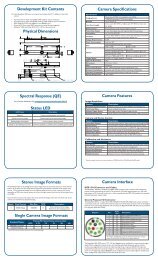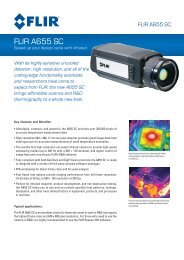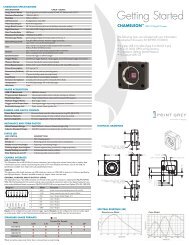Create successful ePaper yourself
Turn your PDF publications into a flip-book with our unique Google optimized e-Paper software.
Point Grey <strong>Blackfly</strong> Technical Reference<br />
8 <strong>Blackfly</strong> Attributes<br />
YUV422 is considered a medium resolution format which transmits 16 bits per pixel. Each Y value has 8 bits, but the U<br />
and V values are shared between 2 pixels. This reduces the bandwidth of an uncompressed video signal by one-third<br />
with little to no visual difference.<br />
YUV411 is considered a low resolution format which transmits 12 bits per pixel. Each Y value has 8 bits, but the U and<br />
V values are shared between 4 pixels. The reduces bandwidth by one half compared to YUV444, but also reduces the<br />
color information being recorded.<br />
YUV can be either packed or planar. Packed is when the Y, U, and V components are stored in a single array<br />
(macropixel). Planar is when the Y, U, and V components are stored separately and then combined to form the image.<br />
Point Grey cameras use packed YUV.<br />
Related Knowledge Base Articles<br />
Title<br />
Article<br />
Understanding YUV data formats Knowledge Base Article 313<br />
8.2 Video Modes Overview<br />
The camera implements a number of video modes, all of which allow the user to select a specific region of interest<br />
(ROI) of the image. Some modes also aggregate pixel values using a process known as "binning". Specifying an ROI may<br />
increase frame rate. Modes that perform binning may increase image intensity.<br />
On Point Grey cameras, binning refers to the aggregation of pixels. Analog binning is aggregation that occurs before<br />
the analog to digital conversion. Digital binning is aggregation that occurs after the analog to digital conversion. Unless<br />
specified otherwise, color data is maintained in binning modes.<br />
In most cases, pixels are added once they are binned. Additive binning usually results in increased image intensity.<br />
Another method is to average the pixel values after aggregation. Binning plus averaging results in little or no change in<br />
the overall image intensity.<br />
Subsampling, or decimation, refers to the skipping of pixels.<br />
Binning and subsampling reduces the effective image resolution. For example, 2x2 binning reduces both the width<br />
and the height by half.<br />
The figures below illustrate binning and subsampling. 2x vertical binning aggregates two adjacent vertical pixel values<br />
to form a single pixel value. 2x horizontal binning works in the same manner, except two adjacent horizontal pixel<br />
values are aggregated. 2x subsampling skips every second pixel horizontally and vertically.<br />
Full Pixels 2x Vertical Binning 2x Horizontal Binning 2x Subsampling<br />
Figure 8.1: Aggregation and Decimation of Pixels<br />
Revised 12/13/2012<br />
Copyright ©2012 Point Grey Research Inc.<br />
42











